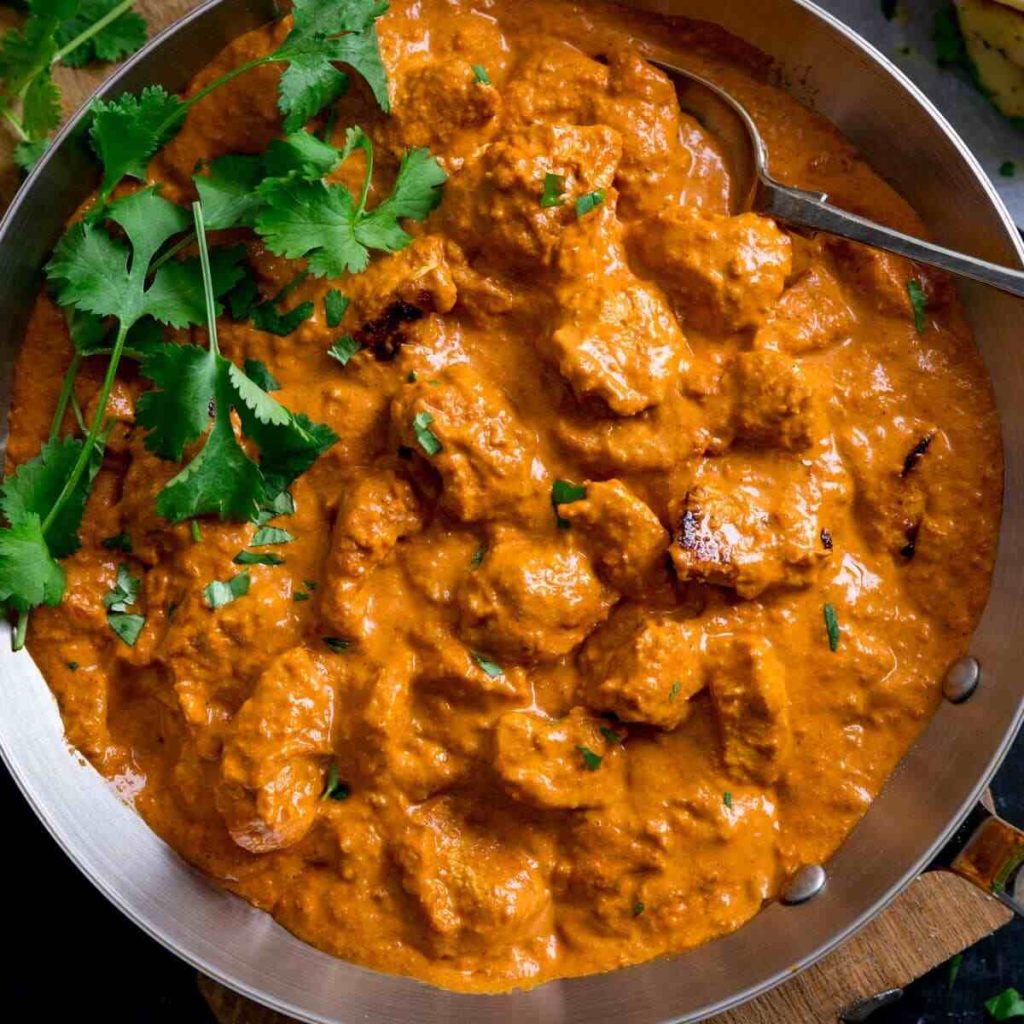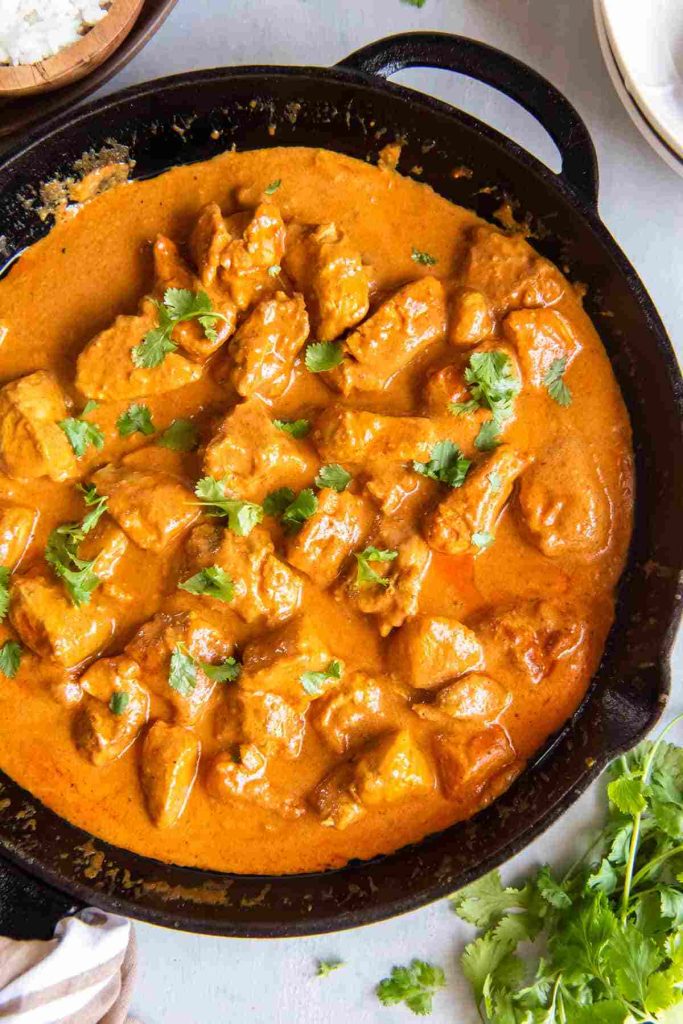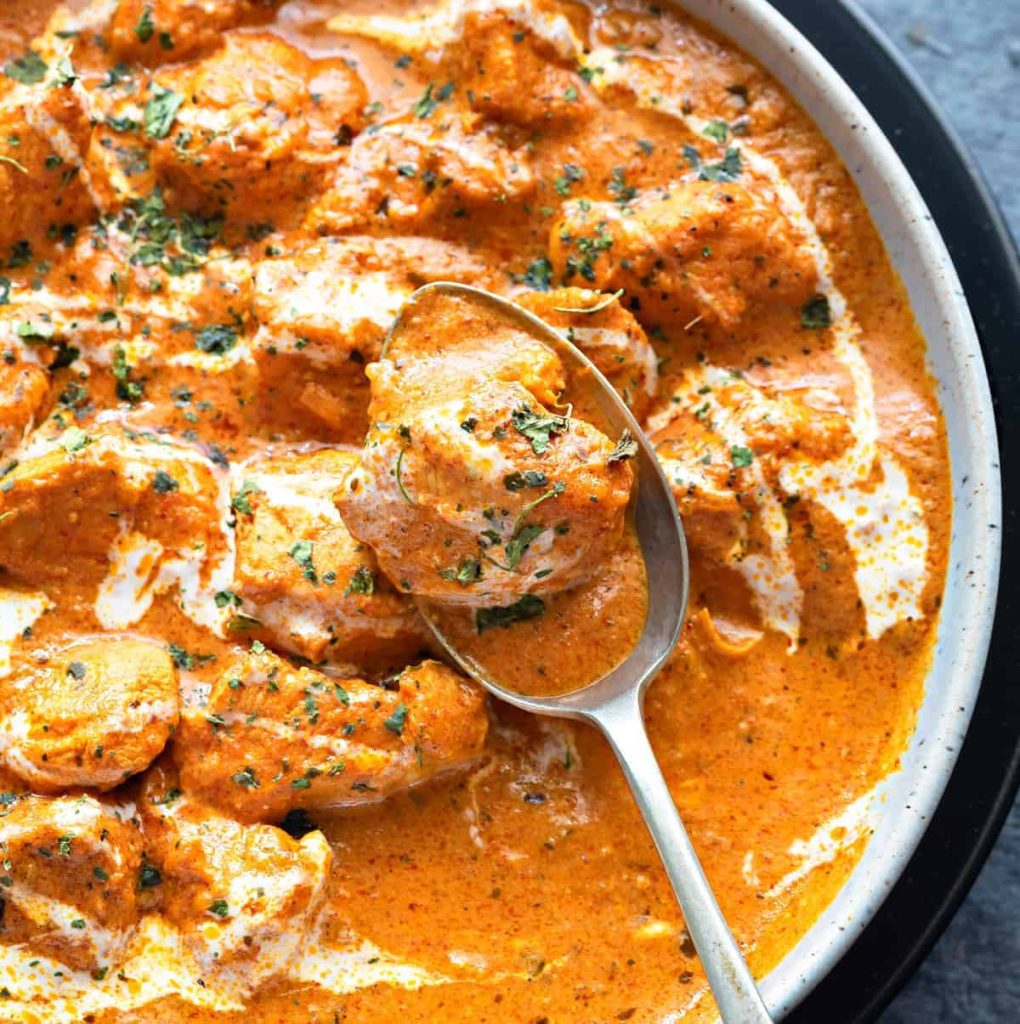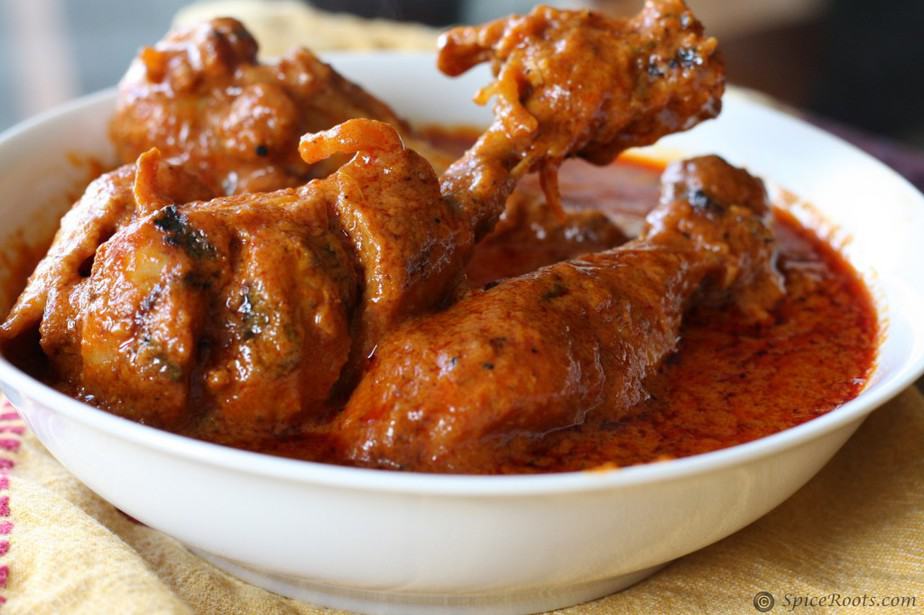Introduciton:
Authentic Butter Chicken Recipe Butter Chicken, also known as “Murgh Makhani,” is one of the most beloved dishes in Indian cuisine. Originating in Delhi in the 1950s, this rich and creamy chicken dish combines tender chicken pieces with a velvety tomato-based sauce, infused with aromatic spices and enriched with butter and cream. The result is a luxurious and comforting meal that tantalizes the taste buds. This article will guide you through an authentic Butter Chicken recipe that is both flavorful and easy to prepare at home.
Ingredients:
For the Chicken Marinade:
500 grams of boneless chicken (thighs or breasts), cut into bite-sized pieces
1/2 cup plain yogurt
1 tablespoon lemon juice
1 tablespoon ginger-garlic paste
1 teaspoon red chili powder
1/2 teaspoon turmeric powder
1/2 teaspoon cumin powder
1/2 teaspoon garam masala
Salt to taste
For the Butter Chicken Sauce:
3 tablespoons butter
1 tablespoon oil
2 large onions, finely chopped
1 tablespoon ginger-garlic paste
2 large tomatoes, pureed
1/2 teaspoon turmeric powder
1 teaspoon red chili powder
1/2 teaspoon cumin powder
1 teaspoon coriander powder
1/2 teaspoon garam masala
1/2 cup heavy cream
1 teaspoon dried fenugreek leaves (kasuri methi), crushed
1 tablespoon honey or sugar (optional)
Fresh cilantro for garnish
Salt to taste
Instructions:
Marinate the Chicken: Start by marinating the chicken to infuse it with flavor. In a bowl, mix the yogurt, lemon juice, ginger-garlic paste, red chili powder, turmeric powder, cumin powder, garam masala, and salt. Add the chicken pieces, making sure they are well coated. This step tenderizes the chicken and ensures it absorbs the spices.
Cook the Chicken: Heat a skillet or grill pan over medium-high heat and add a tablespoon of oil. Cook the marinated chicken pieces until they are about 80% done, ensuring they are slightly charred on the outside but juicy on the inside. This should take about 5-7 minutes.
Prepare the Butter Chicken Sauce: In the same skillet, add butter and let it melt over medium heat. Add the chopped onions and sauté until they turn golden brown. Add ginger-garlic paste and cook for another 2 minutes until the raw aroma disappears.
Add the Spices and Tomato Puree: Stir in the turmeric powder, red chili powder, cumin powder, and coriander powder. Cook for 1-2 minutes until the spices are fragrant. Add the tomato puree and cook until the oil starts separating from the masala, about 10-15 minutes. This step is crucial for developing deep flavors in the sauce.
Finish the Sauce: Reduce the heat to low and add the cooked chicken pieces to the sauce. Pour in the heavy cream, dried fenugreek leaves, and honey or sugar if using. Adjust salt and seasoning as needed.
Serve the Butter Chicken: Garnish with fresh cilantro and a drizzle of cream. Serve hot with steamed basmati rice, naan, or roti. The creamy, buttery sauce paired with tender chicken pieces is sure to make this dish a favorite at any gathering.
Tips for Perfect Butter Chicken:
Quality of Ingredients: Use fresh and high-quality spices, butter, and cream to enhance the taste of the dish.
Marination Time: Allowing the chicken to marinate for a longer time helps it absorb the flavors better.
Balance of Flavors: Adjust the level of sweetness, spiciness, and creaminess according to your preference. The dish should have a perfect balance of all these elements.
Butter Chicken is more than just a dish; it’s an experience that brings together the richness of Indian culinary traditions. Enjoy making this authentic Butter Chicken recipe at home, and let it transport you to the vibrant kitchens of India with every bite!
Is butter chicken meant to be spicy?
Butter Chicken, or “Murgh Makhani,” is one of the most popular Indian dishes worldwide. Known for its creamy, velvety texture and rich tomato-based sauce, Butter Chicken has become synonymous with Indian comfort food. However, a common question arises: Is Butter Chicken meant to be spicy? To answer this, it is important to understand the origins, traditional preparation, and flavor profile of this beloved dish.

The Origins and Flavor Profile of Butter Chicken
Butter Chicken originated in the 1950s at the Moti Mahal restaurant in Delhi, India. It was created as a way to use leftover tandoori chicken by simmering it in a buttery tomato sauce. The result was a dish that combined tender, smoky chicken with a rich, mildly spiced gravy that balanced tanginess, creaminess, and subtle heat.
Unlike many other Indian curries, Butter Chicken is characterized by its mild and creamy sauce. The base of the dish includes tomatoes, butter, cream, and a blend of spices such as cumin, coriander, garam masala, and fenugreek. While these spices do contribute warmth and flavor complexity, they are not meant to overpower the dish with heat. Therefore, Butter Chicken is traditionally not very spicy.
Understanding “Spicy” in Indian Cuisine
The term “spicy” can have different meanings depending on the context. In Western countries, “spicy” often refers to dishes with a lot of heat from chili peppers. However, in Indian cuisine, “spicy” can also mean a dish rich in spices, which may or may not include heat.
Butter Chicken falls into the category of a dish that is “spicy” in the sense that it has a well-balanced mix of spices. However, it is typically low on the Scoville scale (a measure of chili pepper heat). The use of red chili powder in Butter Chicken is generally minimal and is primarily for adding color and a hint of warmth, not for creating intense heat.
Can Butter Chicken Be Spicy?
While Butter Chicken is traditionally mild, the spice level can be adjusted to suit individual preferences. Some chefs and home cooks might add extra green chilies or more red chili powder to increase the heat. This approach might cater to those who prefer a spicier version, but it deviates from the classic preparation.
One of the beauties of Butter Chicken is its versatility. For those who prefer a gentle heat, adding a small amount of chili powder can enhance the flavor without overpowering the dish’s signature creaminess. On the other hand, for those who like their food fiery, adding fresh green chilies or using a spicier chili powder can give Butter Chicken an extra kick.
Why Butter Chicken Is Usually Mild
Authentic Butter Chicken Recipe The mildness of Butter Chicken makes it accessible to a wide range of palates, which is one of the reasons for its global popularity. The rich and creamy sauce, infused with aromatic spices, provides a comforting and indulgent experience that doesn’t overwhelm the senses with heat. This balance of flavors is especially appealing to those who may be new to Indian cuisine or prefer milder dishes.
Conclusion
So, is Butter Chicken meant to be spicy? Traditionally, no—it is intended to be a mildly spiced dish with a creamy, buttery sauce that allows the complex flavors of the spices to shine through without excessive heat. However, as with most recipes, Butter Chicken can be customized to individual taste preferences. Whether you prefer it mild or with a bit more spice, the essence of Butter Chicken lies in its rich, harmonious blend of flavors, making it a timeless favorite across the globe.
How long can you eat butter chicken for?
Authentic Butter Chicken Recipe Butter Chicken, or “Murgh Makhani,” is a popular dish that is loved for its rich, creamy sauce and tender chicken pieces. Like many prepared foods, it is important to know how long Butter Chicken can be safely stored and consumed. This depends on various factors such as storage conditions, ingredients used, and how it is handled after cooking. Here is a comprehensive guide on the shelf life of Butter Chicken and how to ensure it stays fresh and safe to eat.
1.Refrigerating Butter Chicken
Once cooked, Butter Chicken can be stored in the refrigerator to keep it fresh. When refrigerated properly:
Refrigerator Shelf Life: Butter Chicken can be safely stored in an airtight container in the refrigerator for 3 to 4 days. This timeframe is based on general food safety guidelines for cooked poultry dishes.
Storage Tips: To maximize freshness, allow the Butter Chicken to cool to room temperature before placing it in the refrigerator.
Reheating Instructions: When reheating Butter Chicken, ensure it is heated thoroughly to an internal temperature of 165°F (74°C). Reheat in a microwave, on the stovetop, or in an oven until piping hot. Stir occasionally to distribute heat evenly.
2.Freezing Butter Chicken
Freezing is an excellent way to extend the shelf life of Butter Chicken if you want to enjoy it later.
Freezer Shelf Life: Butter Chicken can be stored in the freezer for up to 3 months. Beyond this period, the quality may decline, but it is still safe to eat as long as it has been continuously frozen at 0°F (-18°C) or lower.
Freezing Tips: Divide the Butter Chicken into portion-sized containers or freezer bags for easy thawing and reheating. Make sure to leave some space in the container or bag, as liquids expand when frozen.
Thawing Instructions: To thaw frozen Butter Chicken, transfer it from the freezer to the refrigerator and let it thaw overnight. Alternatively, you can use the defrost setting on a microwave if you need it faster. Once thawed, reheat it as mentioned above.
3.Signs Butter Chicken Has Gone Bad
Even with proper storage, there are a few signs that Butter Chicken has gone bad and should not be consumed:
Unpleasant Odor: A sour or off smell is a clear indicator that the dish is no longer safe to eat.
Texture Changes: If the sauce appears separated, curdled, or has an unusual slimy texture, it’s best to discard it.
Mold Growth: Any visible signs of mold, even on just one part of the dish, mean it should be thrown away immediately.

4.Factors That Affect Shelf Life
The shelf life of Butter Chicken can vary depending on certain factors:
Ingredients Used: If additional ingredients like cream or yogurt are used, the shelf life may be shorter due to their perishable nature.
Storage Conditions: Properly sealing the dish in an airtight container helps prevent bacteria from entering and keeps the dish fresh for longer.
Handling Practices: Ensure utensils and hands are clean when handling leftovers to prevent cross-contamination.
5.Can You Eat Butter Chicken After a Week?
While it might still be safe to eat Butter Chicken after a week in the refrigerator, it is not recommended. The quality and safety of the dish can deteriorate significantly after the 3-4 day mark. To be on the safe side, consume refrigerated Butter Chicken within the recommended timeframe or freeze it if you plan to keep it longer.
Conclusion
Butter Chicken is a delightful dish that can be safely enjoyed for 3 to 4 days when refrigerated and up to 3 months when frozen. Proper storage, handling, and reheating practices are essential to maintain its quality and safety. When in doubt, always trust your senses—if it looks, smells, or tastes off, it’s best to discard it. Enjoy your Butter Chicken fresh or save it for later with confidence!
Why does my butter chicken taste bland?
Butter Chicken, or “Murgh Makhani,” is renowned for its rich, creamy sauce and complex blend of spices that deliver a flavorful and comforting experience. However, sometimes home-cooked Butter Chicken can turn out bland, lacking the depth and richness that makes this dish so beloved. If your Butter Chicken tastes bland, several factors could be contributing to this lack of flavor. Let’s explore some common reasons and how to fix them.
1.Insufficient Marination of Chicken
One of the key steps in making flavorful Butter Chicken is marinating the chicken properly. The marinade typically includes yogurt, lemon juice, ginger-garlic paste, and spices like red chili powder, turmeric, cumin, and garam masala.
Why It Matters: Marinating the chicken not only tenderizes it but also infuses it with flavor. If the chicken is not marinated long enough (ideally for at least a few hours or overnight), it won’t absorb the spices well.
Solution: Ensure the chicken is marinated for a minimum of 1-2 hours, but for the best results, let it sit overnight in the refrigerator. This allows the flavors to penetrate deeper into the meat.
2.Not Using Fresh or High-Quality Spices
Spices are the heart of any good Butter Chicken recipe. The spices add depth, warmth, and a distinctive flavor profile to the dish. If the spices you are using are old or of low quality, the flavor will be muted.
Why It Matters: Spices lose their potency over time, especially if not stored properly in airtight containers away from heat and light.
Solution: Use fresh, high-quality spices and ensure they are stored correctly. Toasting whole spices like cumin or coriander before grinding them can also enhance their flavor. This simple step releases essential oils and intensifies the spice’s aroma and taste.
3.Underseasoning the Sauce
A common mistake when cooking Butter Chicken is not seasoning the sauce adequately. The rich, creamy tomato-based sauce needs a good balance of salt, sweetness, and acidity to shine.
Why It Matters: Salt enhances the natural flavors of ingredients, while a touch of sweetness (from honey or sugar) and acidity (from tomatoes or lemon juice) helps balance the richness of the sauce.
Solution: Taste the sauce as it cooks and adjust the seasoning accordingly. A well-seasoned Butter Chicken should have a balanced combination of savory, sweet, and tangy flavors.
4.Not Cooking the Tomato Base Long Enough
The tomato base is the foundation of Butter Chicken sauce. Cooking the tomatoes properly is crucial for developing deep flavors.
Why It Matters: If the tomato base is not cooked long enough, the raw taste of tomatoes will dominate, leading to a lack of depth in the sauce.
Solution: Sauté the tomatoes with the spices until the oil separates from the sauce (about 10-15 minutes). This step allows the flavors to meld and the rawness of the tomatoes to cook off.
5.Skimping on Butter and Cream
The “butter” in Butter Chicken is not just for show; it is a key ingredient that gives the dish its signature richness and flavor.
Why It Matters: Butter and cream balance the spices and create a luxurious texture. Skimping on these ingredients can result in a watery, bland sauce.
Solution: Use a generous amount of butter and cream in your Butter Chicken. You can adjust the amount to your liking, but don’t omit them, as they are essential for the authentic taste.
6.Overcooking or Undercooking the Chicken
Authentic Butter Chicken Recipe The texture of the chicken can also impact the overall flavor experience. If the chicken is overcooked, it can become dry and chewy, making it less enjoyable.
Why It Matters: Properly cooked chicken retains moisture and absorbs more flavors from the sauce.
Solution: Cook the chicken pieces until they are just done. Then, simmer them in the sauce to allow the flavors to meld without overcooking.

7.Missing Aromatics
Aromatics like ginger, garlic, and onions are crucial to building a robust flavor base in Butter Chicken. Skipping these ingredients or not cooking them enough can leave the dish lacking in depth.
Why It Matters: Ginger and garlic add a pungent kick, while onions provide sweetness and body to the sauce.
Solution: Sauté the aromatics until they are golden brown before adding the tomatoes and spices. This step ensures they release their full flavor potential.
Conclusion
If your Butter Chicken tastes bland, it’s likely due to one or more of these common mistakes. By ensuring proper marination, using fresh spices, seasoning well, cooking the tomato base thoroughly, and not skimping on butter and cream, you can transform your Butter Chicken from bland to bursting with flavor. Remember, the key to a delicious Butter Chicken lies in balancing spices, richness, and proper cooking techniques. Enjoy the process, and soon you’ll master this classic dish!
What’s the difference between Butter Chicken and Chicken Tikka Masala?
Butter Chicken and Chicken Tikka Masala are two of the most popular dishes in Indian cuisine and are often mistaken for one another due to their similarities in appearance and ingredients. However, there are key differences between the two in terms of their origins, preparation methods, flavor profiles, and ingredients. Understanding these differences will help you appreciate the unique characteristics of each dish.
1.Origins
Butter Chicken (Murgh Makhani): Butter Chicken was invented in the 1950s in Delhi, India, at the Moti Mahal restaurant. It was created to make use of leftover tandoori chicken by simmering it in a buttery tomato-based sauce. The dish quickly became popular for its creamy, mildly spiced gravy and tender chicken pieces.
Chicken Tikka Masala: The origins of Chicken Tikka Masala are widely debated, but it is often considered a product of the Indian diaspora in the UK. It is believed to have been created by Indian chefs in Britain in the 1960s or 1970s to cater to the British palate, which preferred a spicier, thicker sauce with a more pronounced tomato flavor.
2.Preparation and Cooking Method
Butter Chicken: The chicken used in Butter Chicken is typically marinated in yogurt and spices, then cooked in a tandoor (a traditional clay oven) or on a grill. The cooked chicken is then simmered in a rich, creamy sauce made from tomatoes, butter, cream, and mild spices. The focus is on achieving a smooth, velvety texture with a balanced, mildly spiced flavor.
Chicken Tikka Masala: Chicken Tikka Masala begins with chicken tikka, which consists of boneless chicken pieces marinated in yogurt and spices and then grilled or roasted. The tikka is then added to a masala sauce made from tomatoes, onions, garlic, ginger, and a more extensive array of spices, including cumin, coriander, turmeric, and garam masala. The sauce is thicker and more intensely spiced than Butter Chicken, often with a slightly smoky flavor due to the grilled chicken pieces.
3.Sauce and Ingredients
Butter Chicken: The sauce is characterized by its creamy, buttery texture and mild spice level. Key ingredients include butter, cream, tomatoes, and mild spices such as fenugreek (methi) leaves, garam masala, and coriander. The sauce is typically sweetened with honey or sugar to balance the tanginess of the tomatoes, and cashew paste may be added for extra richness.
Chicken Tikka Masala: The sauce for Chicken Tikka Masala is usually thicker, spicier, and more robust in flavor compared to Butter Chicken. It often contains more tomatoes, along with onions, garlic, ginger, and a complex blend of spices such as cumin, coriander, turmeric, paprika, and garam masala. The sauce may or may not contain cream, and yogurt is sometimes added to achieve a slightly tangy taste.
4.Flavor Profile
Butter Chicken: The flavor of Butter Chicken is rich, creamy, and slightly sweet with a mild level of spice. The emphasis is on a smooth, buttery sauce that complements the tender chicken. The use of fenugreek leaves gives it a distinctive, earthy aroma and flavor.
Chicken Tikka Masala: Chicken Tikka Masala is known for its bold, spicy, and tangy flavors. It has a more pronounced tomato and spice profile, with a hint of smokiness from the grilled chicken tikka. The sauce is often spicier than Butter Chicken, making it more appealing to those who prefer a bit of heat in their food.
5.Consistency and Appearance
Butter Chicken: The sauce of Butter Chicken is smoother, creamier, and slightly runnier. Its orange-red color comes from the use of tomatoes and cream, resulting in a velvety and glossy appearance.
Chicken Tikka Masala: The sauce of Chicken Tikka Masala is thicker, chunkier, and more vibrant in color, ranging from bright red to deep orange, depending on the use of tomatoes and spices. It has a more textured appearance due to the addition of onions and a more significant amount of spices.
6.Serving and Pairing
Butter Chicken: Due to its rich and creamy nature, Butter Chicken is often served with naan (Indian flatbread), paratha, or steamed basmati rice. The mild flavor profile also makes it a good pairing with buttery or garlic naan.
Chicken Tikka Masala: Chicken Tikka Masala is typically enjoyed with naan, chapati, or a variety of rice dishes like jeera rice or pulao. Its spicier and tangier flavors pair well with plain rice or bread that can help balance the heat.
7.Popularity and Global Appeal
Butter Chicken: Butter Chicken is globally popular and often seen as a gateway dish for those new to Indian cuisine because of its mild, creamy, and universally appealing flavor profile.
Chicken Tikka Masala: Chicken Tikka Masala is often referred to as “Britain’s national dish” due to its immense popularity in the UK. It is a staple in British Indian restaurants and a beloved comfort food for many who enjoy a slightly spicier option.
Conclusion
Authentic Butter Chicken Recipe While Butter Chicken and Chicken Tikka Masala may look similar, their differences lie in their origins, preparation methods, ingredients, and flavor profiles. Butter Chicken offers a rich, creamy, and mildly spiced experience, while Chicken Tikka Masala delivers a bold, tangy, and spicier taste. Both dishes are delicious in their own right and provide unique takes on Indian cuisine that appeal to a variety of palates. A high blood pressure diet menu: Oats with berries, grilled chicken salad, steamed veggies, quinoa, and low-sodium snacks. Heart-healthy dinner: Grilled salmon with quinoa, steamed broccoli, a mixed green salad with olive oil, and a fruit bowl for dessert.

